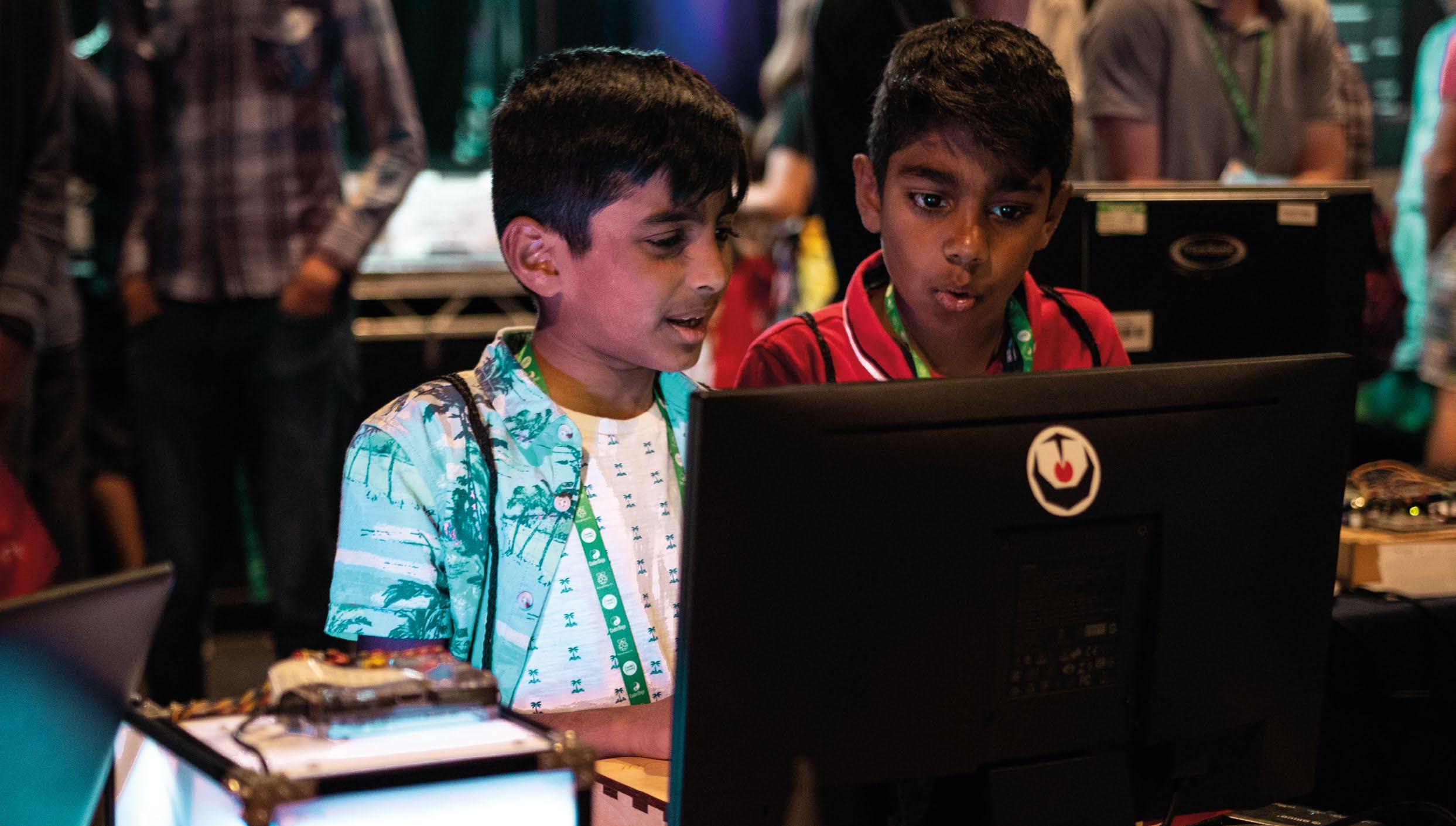
6 minute read
ALTERNATIVE CONCEPTIONS
ADDRESSING STUDENTS’ ALTERNATIVE CONCEPTIONS
Addressing misconceptions in computing develops students’ understanding, development and confidence
Advertisement
Alternative conceptions (often referred to as misconceptions) are beliefs commonly held about a concept by students that are overly simplified or inaccurate. Where these beliefs contradict with reality or accepted scientific understanding, they can cause confusion and affect students’ efficacy and, ultimately, their performance.1 It is therefore vital that computing educators understand commonly held alternative conceptions, how they arise, and how they can be addressed.
Although there is little research that has evidenced this, we suspect there are a number of alternative conceptions around computing. We must therefore also look to research in other subjects that form the traditions that underpin computing, in particular maths, science, and engineering. Some psychologists claim that alternative conceptions can be very persistent.2
In presenting learners with accurate conceptions that challenge their existing understanding, a state of “cognitive disequilibrium”3 is reached, in which
SUMMARY
Alternative conceptions (commonly known as misconceptions) can develop when new knowledge conflicts with a learner’s existing mental models.
Alternative conceptions can be categorised as:
■ Preconceived notions are intuitive but inaccurate leaps made about new ideas, based on existing knowledge ■ Non-scientific beliefs can arise when a learner’s mental models have been informed by non-authoritative sources and are counter to accepted science ■ Conceptual misunderstandings occur when instruction fails to challenge existing mental models and learners attempt to resolve these independently with mixed success ■ Vernacular misconceptions occur where new terminology is the same as that used in another context or everyday language, but with another meaning ■ Factual misconceptions derive from false facts or information that have been assimilated into memory without being challenged
Become familiar with commonly occurring misconceptions: ■ Review existing research into alternative conceptions in computing ■ Reflect on your own experience ■ Share common alternative conceptions with your peers and the community
Identify alternative conceptions through: ■ Varied opportunities for classroom talk ■ Diagnostic multiple-choice questions
Effective ways to address alternative conceptions include: ■ Constructing individual or group concept maps ■ Reach consensus around a concept using peer instruction learners must reconcile the conflicting pieces of information. While this creates an opportunity to replace an alternative conception, learners may choose to discard accurate information that doesn’t fit with their existing mental models. Educators therefore need to be aware of common alternative conceptions that their learners may hold. They should develop a range of strategies that support learners through their misconceptions, encouraging them to recognise them as wrong, but without labelling them in this way.
Sources of alternative conceptions
According to Piaget, learners build new understanding by combining experience with existing mental models. Educators help facilitate this learning by providing learning experiences and supporting learners to integrate the experience with their existing understanding. An alternative conception can arise in a number of ways when learners’ experiences and their mental models interact in different ways. Research4 from science education proposes five categories of alternative conceptions:
■ Preconceived notions involve learners making intuitive conceptual leaps based on their everyday experience. They do not have sufficient relevant experience of a concept or phenomenon, so they use their existing experience to fill in the gaps. For example, learners who are used to Scratch, which automatically handles concurrent execution of code, may expect similar behaviour from Python.
■ Non-scientific beliefs can arise when a learner’s mental models have been informed by information provided by a non-authoritative source, counter to accepted science. An example from programming might be the ‘superbug’5 — a belief that a computer possesses conceptions that their learners might develop. This reflection might include:
■ Reviewing the research about common alternative conceptions in programming6, 7 (there is limited research into wider areas of computing)
■ Reflecting on their own experience of teaching a topic, and any alternative conceptions that past learners exhibited ■ Discussion with peers sharing their collective experience of alternative conceptions (as well as strategies to address them)
innate intelligence that can go beyond what it is told to do, which causes the learner to have unrealistic expectations of the machine. ■ Conceptual misunderstandings occur when learners experience instruction of insufficient depth. The experience fails to challenge existing mental models and confront conflicts. Learners attempt to resolve these independently, with mixed success. In computing, we regularly use analogy to unpack and explain abstract concepts. Learners may be left equating the analogy and the concept, unless educators spend time distinguishing between them (see page 46). ■ Vernacular misconceptions occur when terminology and symbols have different meanings in different contexts. Learners can project meaning from their existing mental models onto the new experience, causing confusion. For example, computing shares many terms with maths (variables, graphs, etc.) that have different meanings in the two subjects. ■ Factual misconceptions derive from false facts that have been assimilated into memory without being challenged.
An example is the common belief that
Apple Macs are immune to viruses.
Identifying alternative conceptions
The first step in mitigating alternative conceptions is identification. Educators need an awareness of potential or common alternative conceptions, and the ability to recognise them in their learners. Before teaching new material, it is valuable for educators to reflect on alternative Educators also need strategies to spot misconceptions as they occur. Some techniques include (but aren’t limited to):
■ Classroom talk and discussion: whether this takes the form of questioning, whole-group or peer discussions, providing opportunities for learners to express their understanding and listening to them is crucial ■ Carefully designed multiple-choice questions can be used to probe learners’ understanding and highlight alternative conceptions
Challenging alternative conceptions
Many alternative conceptions can be addressed with relative ease during instruction, and may even be corrected by the learner. However, many will require more work, as the learner already holds a model that they will probably resist replacing. To address these persistent alternative conceptions, learners need the opportunity to construct (or reconstruct) an accurate model. This opportunity can be provided in a number of ways, including:
■ Creating concept maps to help externalise learners’ understanding and highlight their alternative conceptions
before the accurate model can be reassimilated (see page ten). ■ Peer instruction, to help learners explore and challenge their own mental models as they collaborate to form a shared understanding around a concept (see page 56).
In approaching learners’ alternative conceptions, there is no single approach that will work for all learners. However, educators who are able to identify their learners’ common alternative conceptions are better equipped to support their learners’ understanding8, development, and confidence.
REFERENCES
1 Kallia, M. & Sentance, S. (2019). Learning to use functions: The relationship between misconceptions and self-efficacy. Proceedings of the 50th ACM Technical Symposium on Computer Science Education (752-758). helloworld.cc/
misconception1
2 Eggen, P. & Kauchak, D. (2001). Educational Psychology: Windows on Classrooms. Pearson.
helloworld.cc/misconception2
3 Wadsworth, B. J. (1971). Piaget’s theory of cognitive development: An introduction for students of psychology and education. McKay.
helloworld.cc/misconception3
4 Davis, B. G. (1997). Misconceptions as barriers to understanding science. Science teaching reconsidered: A handbook. The National Academies Press, 27-32. helloworld.cc/misconception4 5 Pea, R. D. (1986). Language-independent conceptual “bugs” in novice programming. Journal of educational computing research, 2(1), 25-36.
helloworld.cc/misconception5
6 Sorva, J. (2018). Misconceptions and the Beginner Programmer. In: Computer Science Education: Perspectives on Teaching and Learning in School, 171. helloworld.cc/misconception6 7 Swidan, A., Hermans, F., & Smit, M. (2018). Programming Misconceptions for School Students. Proceedings of the 2018 ACM Conference on International Computing Education Research (151159). helloworld.cc/misconception7 8 Sadler, P. M. et al. (2013). The Influence of Teachers’ Knowledge on Student Learning in Middle School Physical Science Classrooms. American Educational Research Journal, 50(5), 1020-1049.










